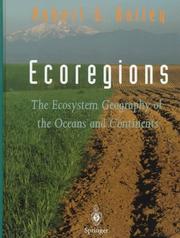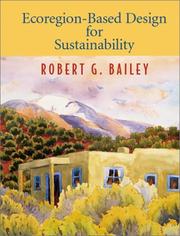| Listing 1 - 4 of 4 |
Sort by
|
Book
Year: 1978 Publisher: Tulsa (Okla.): American association of petroleum geologists,
Abstract | Keywords | Export | Availability | Bookmark
 Loading...
Loading...Choose an application
- Reference Manager
- EndNote
- RefWorks (Direct export to RefWorks)

ISBN: 0387983112 0387983058 1461222001 Year: 1998 Publisher: New York (N.Y.) : Springer,
Abstract | Keywords | Export | Availability | Bookmark
 Loading...
Loading...Choose an application
- Reference Manager
- EndNote
- RefWorks (Direct export to RefWorks)
Ecoregions applies the principles described in Bailey's Ecosystem Geography to describe and characterize the major terrestrial and aquatic ecological zones of the Earth. Robert Bailey's system for classifying ecoregions has had a major influence, and has been adopted by major organizations such as the US Forest Service and The Nature Conservancy. This book includes numerous photographs of representative ecoregions, and outstanding color figures are complemented by two full-color maps showing the major ecoregions of the continents and of the oceans. .
Biogeography --- General ecology and biosociology --- Biogeography. --- Ecological regions --- Life sciences. --- Geography. --- Regional planning. --- Urban planning. --- Ecology. --- Geoecology. --- Environmental geology. --- Nature conservation. --- Life Sciences. --- Geography, general. --- Landscape/Regional and Urban Planning. --- Geoecology/Natural Processes. --- Nature Conservation. --- 574.42 --- 574.58 --- 581.9 --- 591.9 --- 574.9 --- 574.9 Biogeography in general. Geographical distribution of organisms --- Biogeography in general. Geographical distribution of organisms --- 591.9 Geographic zoology. Zoogeography. Fauna. Geographic distribution of animals --- Geographic zoology. Zoogeography. Fauna. Geographic distribution of animals --- 581.9 Geographic botany. Plant geography (phytogeography). Floras. Geographic distribution of plants --- Geographic botany. Plant geography (phytogeography). Floras. Geographic distribution of plants --- 574.58 Aquatic biocoenoses --- Aquatic biocoenoses --- 574.42 Formation and development of terrestrial biocoenoses and ecosystems. --- Formation and development of terrestrial biocoenoses and ecosystems. --- Biotic communities --- Biogéographie --- Classification. --- Ecoregions --- Areography (Biology) --- Geographical distribution of animals and plants --- Species --- Species distribution --- Biology --- Geography --- Formation and development of terrestrial biocoenoses and ecosystems --- Geographical distribution --- Ecology . --- Conservation of nature --- Nature --- Nature protection --- Protection of nature --- Conservation of natural resources --- Applied ecology --- Conservation biology --- Endangered ecosystems --- Natural areas --- Geoecology --- Environmental protection --- Physical geology --- Cities and towns --- City planning --- Civic planning --- Land use, Urban --- Model cities --- Redevelopment, Urban --- Slum clearance --- Town planning --- Urban design --- Urban development --- Urban planning --- Land use --- Planning --- Art, Municipal --- Civic improvement --- Regional planning --- Urban policy --- Urban renewal --- Regional development --- State planning --- Human settlements --- Landscape protection --- Cosmography --- Earth sciences --- World history --- Balance of nature --- Bionomics --- Ecological processes --- Ecological science --- Ecological sciences --- Environment --- Environmental biology --- Oecology --- Environmental sciences --- Population biology --- Conservation --- Government policy --- Management --- Ecology

ISBN: 1280009608 9786610009602 0387225978 0387954295 Year: 2002 Publisher: New York, NY : Springer New York : Imprint: Springer,
Abstract | Keywords | Export | Availability | Bookmark
 Loading...
Loading...Choose an application
- Reference Manager
- EndNote
- RefWorks (Direct export to RefWorks)
This book completes Robert G. Bailey's celebrated study of ecoregions, begun in the landmark Ecosystem Geography (1996) and further articulated in Ecoregions (1998). In this third installment, the author expands his system for defining large-scale ecological zones to encompass principles of land management, regional planning, and design. In an engaging, non-technical discussion, he shows how larger patterns and processes that characterize a region - its climate, topography, soils, vegetation, fauna, and human culture - provide essential keys to the sustainability of ecosystems. Ecoregion-Based Design for Sustainability will be welcomed by land and resource managers, landscape architects and urban planners, ecologists, students, and anyone interested in ecology-based design. "Bob Bailey ÄisÜ the man behind the ecosystem mapping of the world." (Lingua Franca Reviews of Ecoregions) "The book provides easy access to the geographic distribution, characteristics, and processes operating behind every major ecosystem in the world." (Geoscience Canada) "For schools and colleges Ecoregions offers an invaluable source of description, interpretation and analysis of global patterns of ecosystem distribution and successfully provides the reader with a means of making sense of these patterns." (Geography) Robert G. Bailey is a geographer with the United States Forest Service in Fort Collins, Colorado, and leader of the agency's Ecosystem Management Analysis Center.
Landscape ecology. --- Ecological landscape design. --- Regional planning --- Environmental aspects. --- Environmental management. --- Regional planning. --- Architecture. --- Culture-Study and teaching. --- Environmental Management. --- Landscape/Regional and Urban Planning. --- Landscape Ecology. --- Landscape Architecture. --- Cities, Countries, Regions. --- Regional and Cultural Studies. --- Urban planning. --- Landscape architecture. --- Culture—Study and teaching. --- Ecology --- Cities and towns --- City planning --- Civic planning --- Land use, Urban --- Model cities --- Redevelopment, Urban --- Slum clearance --- Town planning --- Urban design --- Urban development --- Urban planning --- Land use --- Planning --- Art, Municipal --- Civic improvement --- Urban policy --- Urban renewal --- Regional development --- State planning --- Human settlements --- Landscape protection --- Environmental stewardship --- Stewardship, Environmental --- Environmental sciences --- Management --- Architecture, Western (Western countries) --- Building design --- Buildings --- Construction --- Western architecture (Western countries) --- Art --- Building --- Horticultural service industry --- Landscape gardening --- Landscaping industry --- Government policy --- Design and construction --- City planning.
Book
ISBN: 1441903917 0387895159 0387895167 9780387895154 9781441903914 9780387895161 Year: 2009 Publisher: New York (N.Y.): Springer,
Abstract | Keywords | Export | Availability | Bookmark
 Loading...
Loading...Choose an application
- Reference Manager
- EndNote
- RefWorks (Direct export to RefWorks)
The first edition of this book, Ecosystem Geography, examined the distribution of ecosystems at different scales, and the processes that have differentiated them. It presented the principles for ecosystems mapping and explored the connections between ecosystem geography, conservation, and management. Ecosystem Geography was written in 1996, at a time when few published materials on ecosystem geography were available, and none had systematically elaborated the principles underlying the mapping of ecosystems in a form accessible to advanced students and practitioners. This second edition, Ecosystem Geography: From Ecoregions to Sites, builds on the strengths of its predecessor, incorporating new information and clarifying concepts presented in the first edition. New sections address how ecoregion boundaries were determined, ecoregion redistribution under climate change, ecosystem processes (such as fire regimes), empirical versus genetic approaches to classification, and human modification to ecosystems, such as through the introduction of invasive species. From reviews of the first edition: "An important book, richly illustrated with clear diagrams, maps, and photos. A major contribution to ecosystem ecology and an essential acquisition." –Choice "The new ‘ecosystem management’ demands an understanding of ecosystems and the relationships between them. In short, it requires a sound geographical knowledge of ecosystems. Ecosystem Geography lays a firm foundation for such knowledge." –Progress in Physical Geography "The book is essential reading for ecologists and natural area managers interested in ecosystem management and understanding how their landscapes fit into the larger picture regionally, continentally, and globally." –Natural Areas Journal About the Author: Robert G. Bailey is a geographer with the United States Forest Service, Rocky Mountain Research Station, in Fort Collins, Colorado, and the former leader of the agency's Ecosystem Management Analysis Center. His work involves the application of ecosystem geography to ecological planning and design.
Ecology. --- Geography. --- Life sciences. --- Nature Conservation. --- Regional planning. --- Biotic communities --- Natural resources surveys --- Ecosystem management --- Ecology --- Earth & Environmental Sciences --- Classification --- Natural resources surveys. --- Ecosystem management. --- Ecosystems management --- Natural resources inventories --- Biocenoses --- Biocoenoses --- Biogeoecology --- Biological communities --- Biomes --- Biotic community ecology --- Communities, Biotic --- Community ecology, Biotic --- Ecological communities --- Ecosystems --- Natural communities --- Management --- Urban planning. --- Geoecology. --- Environmental geology. --- Nature conservation. --- Life Sciences. --- Geography, general. --- Landscape/Regional and Urban Planning. --- Geoecology/Natural Processes. --- Applied ecology --- Environmental management --- Nature conservation --- Biodiversity conservation --- Economic surveys --- Population biology --- Conservation of nature --- Nature --- Nature protection --- Protection of nature --- Conservation of natural resources --- Conservation biology --- Endangered ecosystems --- Natural areas --- Regional development --- Regional planning --- State planning --- Human settlements --- Land use --- Planning --- City planning --- Landscape protection --- Cosmography --- Earth sciences --- World history --- Balance of nature --- Biology --- Bionomics --- Ecological processes --- Ecological science --- Ecological sciences --- Environment --- Environmental biology --- Oecology --- Environmental sciences --- Conservation --- Government policy --- Ecology . --- Geoecology --- Environmental protection --- Physical geology --- Cities and towns --- Civic planning --- Land use, Urban --- Model cities --- Redevelopment, Urban --- Slum clearance --- Town planning --- Urban design --- Urban development --- Urban planning --- Art, Municipal --- Civic improvement --- Urban policy --- Urban renewal --- Biotic communities - Classification --- ecosystems --- Spatial distribution --- world --- City planning.
| Listing 1 - 4 of 4 |
Sort by
|

 Search
Search Feedback
Feedback About UniCat
About UniCat  Help
Help News
News